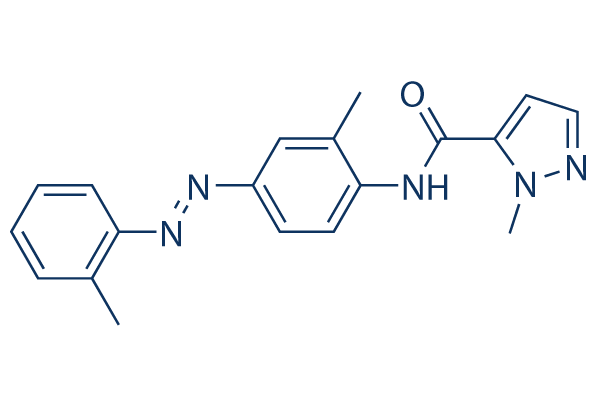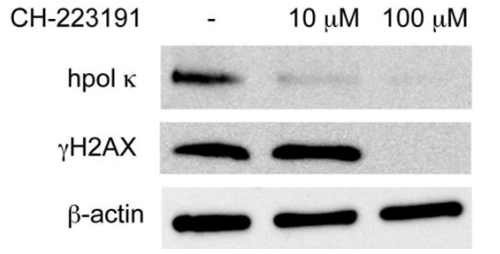
- Bioactive Compounds
- By Signaling Pathways
- PI3K/Akt/mTOR
- Epigenetics
- Methylation
- Immunology & Inflammation
- Protein Tyrosine Kinase
- Angiogenesis
- Apoptosis
- Autophagy
- ER stress & UPR
- JAK/STAT
- MAPK
- Cytoskeletal Signaling
- Cell Cycle
- TGF-beta/Smad
- DNA Damage/DNA Repair
- Compound Libraries
- Popular Compound Libraries
- Customize Library
- Clinical and FDA-approved Related
- Bioactive Compound Libraries
- Inhibitor Related
- Natural Product Related
- Metabolism Related
- Cell Death Related
- By Signaling Pathway
- By Disease
- Anti-infection and Antiviral Related
- Neuronal and Immunology Related
- Fragment and Covalent Related
- FDA-approved Drug Library
- FDA-approved & Passed Phase I Drug Library
- Preclinical/Clinical Compound Library
- Bioactive Compound Library-I
- Bioactive Compound Library-Ⅱ
- Kinase Inhibitor Library
- Express-Pick Library
- Natural Product Library
- Human Endogenous Metabolite Compound Library
- Alkaloid Compound LibraryNew
- Angiogenesis Related compound Library
- Anti-Aging Compound Library
- Anti-alzheimer Disease Compound Library
- Antibiotics compound Library
- Anti-cancer Compound Library
- Anti-cancer Compound Library-Ⅱ
- Anti-cancer Metabolism Compound Library
- Anti-Cardiovascular Disease Compound Library
- Anti-diabetic Compound Library
- Anti-infection Compound Library
- Antioxidant Compound Library
- Anti-parasitic Compound Library
- Antiviral Compound Library
- Apoptosis Compound Library
- Autophagy Compound Library
- Calcium Channel Blocker LibraryNew
- Cambridge Cancer Compound Library
- Carbohydrate Metabolism Compound LibraryNew
- Cell Cycle compound library
- CNS-Penetrant Compound Library
- Covalent Inhibitor Library
- Cytokine Inhibitor LibraryNew
- Cytoskeletal Signaling Pathway Compound Library
- DNA Damage/DNA Repair compound Library
- Drug-like Compound Library
- Endoplasmic Reticulum Stress Compound Library
- Epigenetics Compound Library
- Exosome Secretion Related Compound LibraryNew
- FDA-approved Anticancer Drug LibraryNew
- Ferroptosis Compound Library
- Flavonoid Compound Library
- Fragment Library
- Glutamine Metabolism Compound Library
- Glycolysis Compound Library
- GPCR Compound Library
- Gut Microbial Metabolite Library
- HIF-1 Signaling Pathway Compound Library
- Highly Selective Inhibitor Library
- Histone modification compound library
- HTS Library for Drug Discovery
- Human Hormone Related Compound LibraryNew
- Human Transcription Factor Compound LibraryNew
- Immunology/Inflammation Compound Library
- Inhibitor Library
- Ion Channel Ligand Library
- JAK/STAT compound library
- Lipid Metabolism Compound LibraryNew
- Macrocyclic Compound Library
- MAPK Inhibitor Library
- Medicine Food Homology Compound Library
- Metabolism Compound Library
- Methylation Compound Library
- Mouse Metabolite Compound LibraryNew
- Natural Organic Compound Library
- Neuronal Signaling Compound Library
- NF-κB Signaling Compound Library
- Nucleoside Analogue Library
- Obesity Compound Library
- Oxidative Stress Compound LibraryNew
- Plant Extract Library
- Phenotypic Screening Library
- PI3K/Akt Inhibitor Library
- Protease Inhibitor Library
- Protein-protein Interaction Inhibitor Library
- Pyroptosis Compound Library
- Small Molecule Immuno-Oncology Compound Library
- Mitochondria-Targeted Compound LibraryNew
- Stem Cell Differentiation Compound LibraryNew
- Stem Cell Signaling Compound Library
- Natural Phenol Compound LibraryNew
- Natural Terpenoid Compound LibraryNew
- TGF-beta/Smad compound library
- Traditional Chinese Medicine Library
- Tyrosine Kinase Inhibitor Library
- Ubiquitination Compound Library
-
Cherry Picking
You can personalize your library with chemicals from within Selleck's inventory. Build the right library for your research endeavors by choosing from compounds in all of our available libraries.
Please contact us at info@selleckchem.com to customize your library.
You could select:
- Antibodies
- Bioreagents
- qPCR
- 2x SYBR Green qPCR Master Mix
- 2x SYBR Green qPCR Master Mix(Low ROX)
- 2x SYBR Green qPCR Master Mix(High ROX)
- Protein Assay
- Protein A/G Magnetic Beads for IP
- Anti-Flag magnetic beads
- Anti-Flag Affinity Gel
- Anti-Myc magnetic beads
- Anti-HA magnetic beads
- Magnetic Separator
- Poly DYKDDDDK Tag Peptide lyophilized powder
- Protease Inhibitor Cocktail
- Protease Inhibitor Cocktail (EDTA-Free, 100X in DMSO)
- Phosphatase Inhibitor Cocktail (2 Tubes, 100X)
- Cell Biology
- Cell Counting Kit-8 (CCK-8)
- Animal Experiment
- Mouse Direct PCR Kit (For Genotyping)
- New Products
- Contact Us
CH-223191
CH-223191 is a potent and specific aryl hydrocarbon receptor (AhR) antagonist with IC50 of 30 nM.

CH-223191 Chemical Structure
CAS No. 301326-22-7
Purity & Quality Control
Batch:
Purity:
99.75%
99.75
Products often used together with CH-223191
CH-223191 and PD98059 abolish TCDD-induced ERK1/2 phosphorylation and cell proliferation in human colon cancer cells.
Xie G, et al. Am J Physiol Gastrointest Liver Physiol. 2012 May 1;302(9):G1006-15.
CH223191 is intraperitoneally administered 1 hr before FICZ application to modulate AhR activation.
CH-223191 and GNF351 are AhR antagonists that completely inhibit the VRCZ-induced transcription of CYP1A1 and COX-2 in HaCaT cells.
CH-223191 Related Products
| Related Products | SR1 (StemRegenin 1) FICZ BAY-218 Tapinarof BAY 2416964 GNF351 L-Kynurenine | Click to Expand |
|---|---|---|
| Related Compound Libraries | Metabolism Compound Library Anti-cancer Metabolism Compound Library Glutamine Metabolism Compound Library Carbohydrate Metabolism Compound Library Lipid Metabolism Compound Library | Click to Expand |
Biological Activity
| Description | CH-223191 is a potent and specific aryl hydrocarbon receptor (AhR) antagonist with IC50 of 30 nM. | ||
|---|---|---|---|
| Targets |
|
| In vitro | ||||
| In vitro | CH-223191 blocks TCDD-mediated nuclear translocation and DNA binding of AhR, and also causes the inhibition of TCDD-induced cytochrome P450 enzyme activity. [1] In human glioblastoma cells, CH-223191downregulates the TGF-beta/Smad pathway, and reduces clonogenic survival and invasiveness. [2] In SK-N-SH human-derived neuronal cells, CH223191 counteracts the TCDD-induced suppression of neuronal acetylcholinesterase expression. [3] In endothelial cells, CH-223191 potentiates ICAM-1 expression and prevents RelB nuclear translocation. [4] |
|||
|---|---|---|---|---|
| Kinase Assay | Luciferase Reporter Gene Assay | |||
| The cells are lysed with lysis buffer (20 mM Tris-HCl, pH 7.8, 1% Triton X-100, 150 mM NaCl, and 2 mM dithiothreitol). The cell lysate is mixed with luciferase activity assay reagent and luminescence produced for 5 s is measured using a luminometer. | ||||
| Cell Research | Cell lines | HepG2 cells | ||
| Concentrations | 30 nM | |||
| Incubation Time | 1 h | |||
| Method | HepG2 cells were treated with the various concentrations of CH-223191 or flavone for 1 h and then with 3 nM TCDD for 24 h, and then luciferase activity was assayed. |
|||
| Experimental Result Images | Methods | Biomarkers | Images | PMID |
| Western blot | hpol κ / γH2AX |

|
26651356 | |
| In Vivo | ||
| In vivo | CH-223191 (10 mg/kg/day, p.o.) potently prevents TCDD-caused cytochrome P450 induction, liver toxicity, and wasting syndrome in mice. [1] |
|
|---|---|---|
| Animal Research | Animal Models | Male ICR mice |
| Dosages | 10 mg/kg/day | |
| Administration | p.o. | |
Chemical Information & Solubility
| Molecular Weight | 333.39 | Formula | C19H19N5O |
| CAS No. | 301326-22-7 | SDF | Download CH-223191 SDF |
| Smiles | CC1=CC=CC=C1N=NC2=CC(=C(C=C2)NC(=O)C3=CC=NN3C)C | ||
| Storage (From the date of receipt) | |||
|
In vitro |
DMSO : 67 mg/mL ( (200.96 mM) Moisture-absorbing DMSO reduces solubility. Please use fresh DMSO.) Water : Insoluble Ethanol : Insoluble |
Molecular Weight Calculator |
|
In vivo Add solvents to the product individually and in order. |
In vivo Formulation Calculator |
||||
Preparing Stock Solutions
Molarity Calculator
In vivo Formulation Calculator (Clear solution)
Step 1: Enter information below (Recommended: An additional animal making an allowance for loss during the experiment)
mg/kg
g
μL
Step 2: Enter the in vivo formulation (This is only the calculator, not formulation. Please contact us first if there is no in vivo formulation at the solubility Section.)
% DMSO
%
% Tween 80
% ddH2O
%DMSO
%
Calculation results:
Working concentration: mg/ml;
Method for preparing DMSO master liquid: mg drug pre-dissolved in μL DMSO ( Master liquid concentration mg/mL, Please contact us first if the concentration exceeds the DMSO solubility of the batch of drug. )
Method for preparing in vivo formulation: Take μL DMSO master liquid, next addμL PEG300, mix and clarify, next addμL Tween 80, mix and clarify, next add μL ddH2O, mix and clarify.
Method for preparing in vivo formulation: Take μL DMSO master liquid, next add μL Corn oil, mix and clarify.
Note: 1. Please make sure the liquid is clear before adding the next solvent.
2. Be sure to add the solvent(s) in order. You must ensure that the solution obtained, in the previous addition, is a clear solution before proceeding to add the next solvent. Physical methods such
as vortex, ultrasound or hot water bath can be used to aid dissolving.
Tech Support
Answers to questions you may have can be found in the inhibitor handling instructions. Topics include how to prepare stock solutions, how to store inhibitors, and issues that need special attention for cell-based assays and animal experiments.
Tel: +1-832-582-8158 Ext:3
If you have any other enquiries, please leave a message.
* Indicates a Required Field
Tags: buy CH-223191 | CH-223191 supplier | purchase CH-223191 | CH-223191 cost | CH-223191 manufacturer | order CH-223191 | CH-223191 distributor






































